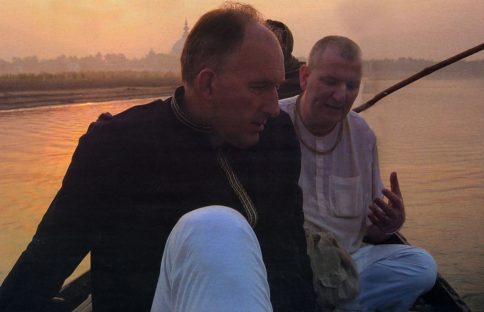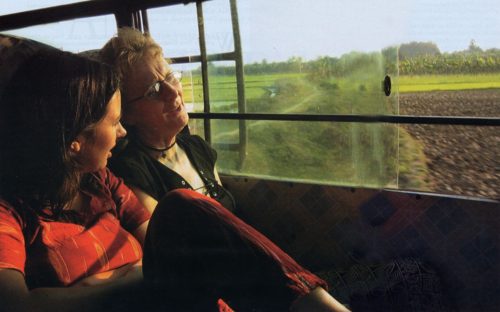A visit to Mayapur proves to be an unforgettable experience for a group from the Emerald Isle.
John Alexander and his group of fourteen children and five adults from a school in Dublin, Ireland, visited Mayapur for a weekend last February. The group had been in Kolkata helping to build a school for underprivileged children. The following is an excerpt from his unpublished diary, entitled Kolkata Omnibus.

We are on our way to Mayapur, the Hare Krishna temple complex dedicated to the Lord Chaitanya. His Divine Grace A. C. Bhakivedanta Swami Prabhupada bought the site and it is now a major place of pilgrimage. We are being driven in the Iskcon bus along a pot-holed highway with little square paddyfields of newly planted rice glistening green and watery in the bright February sunshine. Sile is getting more and more excited as we get closer. It is a dream coming true for her. Sanky's Dad, Pragosh Murphy, arranged this visit months ago and she was the last to join our group two weeks ago.
Sunday, 15th Feb., 12:55 P.M.
In a taxi on my way to the opening of Friends of Calcutta FOKE old people's home run by Sanghita and Michael Hopkins, who is from Bagnelstown, Co. Carlow, and whom I met on my return from India last year.
Mayapur was great. Pragosh Murphy, father of Sankarasana, known as Sanky in Ireland, looked after us really well. Mayapur is near the Bangladesh border, north of Kolkata. It is the birthplace of Lord Chaitanya and the headquarters of the Hare Krishna movement, Iskcon.
We arrived yesterday evening at 5:30 P.M. just as it was getting dark. We went straight to the Temple to start our chanting of the Holy Name. The greeting, whenever you meet someone about the complex, is Hare Krishna and most of us quickly got into the swing of it. The whole thing is colourful and vibrant. Sile was beside herself with ecstasy and Carol and Pat very quickly started swaying and chanting, if not quite jumping up and down with glee. Sophy told Pragosh that she never thought religion could be so much fun! Grace, Marianne and Antoinette loved it too, though the boys were less enthusiastic. Sanky, in his usual incorrigible "chewing gum" manner, gave the impression that he'd seen it all before!
The first thing you feel about the place is the casual informality amidst all the quite elaborate ritual. Spontaneity is the overriding theme and a sense of great individual freedom within the stricture of an ancient and traditional practise. Everyone you meet is welcoming and joyful. There's a subtle measure to the charismatic element. This morning after a particularly heartfelt chanting of love and devotion to Sri Prabhupada in front of his statue, followed by more Hare Krishna singing, I allowed myself to throw my arms in the air and jump to the rhythm. There was a stop and everyone quietly knelt and bowed their heads to the floor in supplication. This was followed immediately by an hour of study with one of the master teachers.
Interestingly the two most visible participants were northsiders from Dublin. The tall thin young man beating his drum and providing the chants in a powerful and infectious tone was Gaurhari from Raheny. He led the hundreds of ecstatic pilgrims around the temple from the altar of Krishna and his consort and gopees to the other shrines like he was the Pied Piper of Hamelin.
The second northsider was our host Pragosh (Paul Murphy) from Clontarf. He was elected recently to be chairman for a year of the worldwide organising committee of Iskcon. This is an honour for him and for Ireland, where there are around 500 members in the movement. He is the very first member to be selected for this position who is not a direct disciple of Sri Prabhupada. Everyone knew him and if we had any problem at all we just had to say we were his personal guests and things were quickly smoothed out!
Last night we joined the Elephant Procession to the Samadhi Temple, an enormous gold-domed marble structure, completed about ten years ago. Pragosh introduced me to Jayapataka Maharaja, a big American in flowing robes and one of Sri Prabhupada's original disciples. I was invited to perform a Puja. For this I had to stand in front of the great animal who was brightly decorated for the occasion and who gazed at me with most gentle eyes, and perform three ceremonies: first with a bundle of burning incense, then with a raised candelabra of Ghee candles and finally with a bowl of rose-petals. Each time I raised these up and rotated them clockwise seven times the crowd around intoned their prayers and the elephant gently flapped his huge ears. The last rotation was accompanied by a surge of energy which filled me from head to toe. The whole scene was dramatically lighted by huge burning torches carried by two smiling devotees, which gave out great heat, while the elephant was being ridden by another four monks.
We met Sile for prashad. She expressed envy at not being present at the puja and said that a great honour had been conferred on us. It was certainly an unforgettable experience. The whole group ate prashad, a sacred meal of spiced vegetables, chapattis and dahl, prepared by holy Brahmins. We sat on our hunkers in a long line eating our simple and inexpensive (30 cents each) holy meal off plates made of leaves with our right hands. Mark had to use his left as he had cut his right one that morning. Most of the youngsters rushed off to Govinda's pizzeria afterwards and Pragosh treated everyone to delicious ice-cream.

Sile and I were the only ones to rise early to join the morning prayers, she at four and me at five o'clock. I meditated for forty minutes on a mat facing Sri Prabhupada while around me hundreds of robed devotees repeated their Hare Krishna mantra using beads to note the repetitions. Two Bengalis beside me were yapping away to each other while Syamananda, another Irish friend, repeated his aloud in my ear. Pragosh interrupted our spiritual practice to invite us for a walk. We went the 300 or so metres down to the River Ganges. There we performed the ritual designed to cleanse sins by splashing the head three times with water. It was now 6:15 A.M. and the rising sun was just becoming visible through the trees surrounding the Samadhi Temple.
We negotiated a rate with the two boatmen in attendance at the ghat and we took a most wondrous ride on a flat-bottomed cot out onto the tranquil morning waters of the mighty river. Bird song intermingled with the prayerful repetitions of the mantras, which Pragosh and Syamananda were intoning. Between my enjoyment of the gentle lapping of the water and the occasional splashing sound of the boatman, propelling us with a single oar from the rear, Pragosh broke my reverie with scraps of conversation. As we got out onto the wide river the sight of people by the water's edge performing morning ablutions was replaced by kingfishers preening their bright plumage among the reeds on the bank and serious looking cormorants planning their breakfast. Pragosh, becoming more voluble, encouraged by my questions, filled me in on the detail of the movement's belief system while I, listening intently, trawled my foot over the side in the cleansing water. Syamananda took beautiful photographs of the great red sun rising over the temple complex with my tiny new Canon digital.
This blissful journey lasted a full forty minutes but we had to return to allow Pragosh to prepare for his morning round of meetings to plan where and how Iskcon would go from here. A visit to his spacious quarters in the epicentre of this worldwide organisation for promoting Krishna Consciousness was followed by a glass each of freshly squeezed pomegranate juice at Govinda's before we shook hands warmly and I thanked him on behalf of us all for an unforgettable experience.
After a proper swim in the clear warm water of the River Ganges I checked that everyone was all right before stealing another twenty minutes with Sile and Pat, who treated me to a roadside ginger and sugar-cane drink, produced on a bicycle-propelled juicer, and a quick tour of the massive Samadhi Temple, where we received Eucharist. An hour later I caught the taxi and amazingly was only thirty minutes late for the opening of the old folks' home. This was definitely low-key in its religiosity compared to Mayapur.
